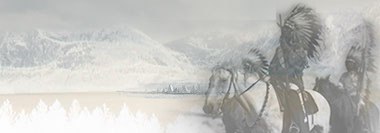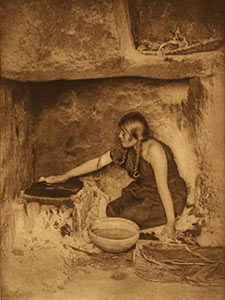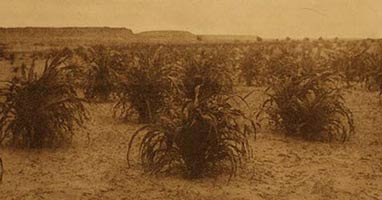 |
 |
 Piki (cornbread) cooked on baking stone. Photo Below - Cornfield. Photos By Edward Curtis |
How Native American Foods
Revolutionized Europe Yummy Gifts to World Breadbasket by David Johnson Oct 09, 2006 Columbus Day Columbus Day, holiday commemorating Christopher Columbus's discovery of America. It has been traditionally celebrated on Oct. 12 throughout most of the United States, parts of Canada, and in several of the Latin American republics. In the United States, however, since the observation in 1971 of the Uniform Holiday Act, it is celebrated on the Monday nearest to Oct. 12. In many parts of America, like Telluride (CO) and Stanford (CA), Indigenous Peoples Day has replaced what was once known as Columbus Day! |
Columbus's Unknown Legacy Just Where Was Columbus? What would Italian cooking be without the tomato? How would Irish history have been different without the potato? What would the Swiss have done without chocolate? These and such products as tobacco, corn, cassava, and most species of bean were unknown in Europe before the voyages of Columbus. As the early explorers encountered these exotic items in the Americas, they brought them to Europe and Africa, where they eventually revolutionized eating habits. Beans Until Columbus, the only beans known in the Old World were soybeans and some uncommon species. Other types of bean widely used today—shell, string, kidney, lima, and pea beans—were cultivated by indigenous peoples of the Americas. Cassava Also known as manioc, this starchy root is native to the Amazon region of South America , where Indians cultivated it. As trade between Africa, Europe, and the New World blossomed, cassava gradually became a staple in parts of Africa. Chocolate The Aztecs drank a chocolate drink, which intrigued the Spanish when they arrived in Mexico around 1500. The Spaniards introduced chocolate to Europe where it quickly became an exotic luxury. In 1657 a London store began selling chocolate and started a trend. As people gathered to drink chocolate and talk, conversation clubs arose. The Cocoa Tree was the most famous. Chocolate was first manufactured in the U.S. at Milton Lower Mills outside Boston, Mass. In the 1870s the Swiss began making milk chocolate, by adding condensed milk to the formula.  Corn
Corn What is known in the U.S. today as corn is actually maize, or was sometimes called Indian corn. In England, "corn" meant wheat, while in Scotland and Ireland it referred to oats. Indians cultivated several varieties of corn& mdash;white, yellow, red, blue, sweet corn, popcorn, and corn to make corn meal. Corn is a mixture of several types of wild grass. Potato From its origins among the Inca of the Andes Mountains, potato cultivation spread through wide areas of the Americas, where it was often a staple crop. The Spanish introduced it to Europe. The English first began to grow potatoes on a large scale. English settlers brought the potato with them to North America after 1600, thus reintroducing it to the New World. In Europe, the potato became a staple in many areas. Failure of the Irish potato crop in the mid-1800s prompted a massive migration to the Americas. Tobacco Early explorers reported seeing Indians smoking tobacco. By the mid-1500s, Spain and Portugal had introduced tobacco to Europe where it gradually became popular. The English began experimenting with the crop in Virginia, which remains a major tobacco producer. Tobacco use and producti on have circled the globe. The Middle East, Turkey, Pakistan, India, China, Russia, Indonesia, and the Philippines all produce tobacco. Cuba and Puerto Rico also grow tobacco and have become important cigar manufacturers. Tomato The Incas and the Aztecs raised tomatoes. Officially a fruit, the tomato, sometimes called the "love apple," did not catch on at once in Europe. Many people believed t omatoes were poisonous. Around 1800, the tomato was reintroduced to the Americas when Europeans brought it to the U.S., where it is the third most common vegetable crop today. |
|
Home | Photo Gallery | Nations/Ski Areas Mapped by State | Nations Directory | Ski Areas Directory | Events | Tributes | Snow/Earth Care
Entry Page | NA Olympic Bid | Shining Moments | Tribal Gifts | Miracles | Donations | Nations Bios | Site Credits | Site Map | Contact Us
Entry Page | NA Olympic Bid | Shining Moments | Tribal Gifts | Miracles | Donations | Nations Bios | Site Credits | Site Map | Contact Us
© Snow Riders of the American Indian Nations/ Native Voices. All Rights Reserved. This site is a world-wide collaboration.